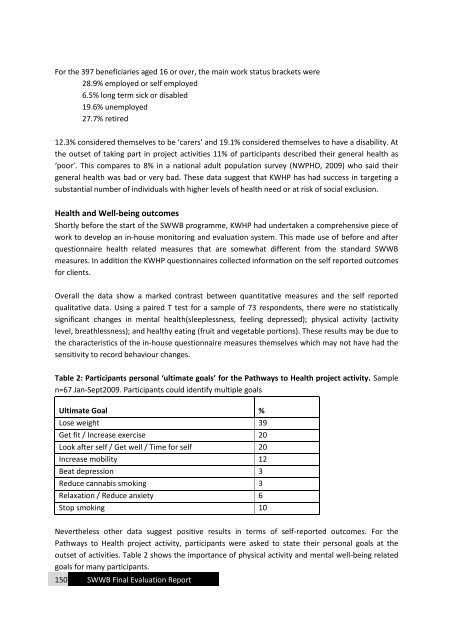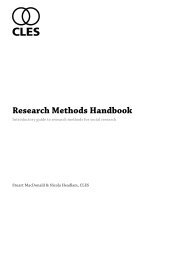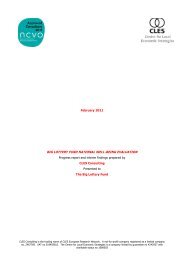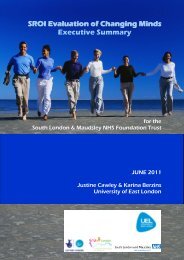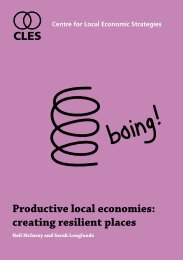Aim and objectives of the report - CLES
Aim and objectives of the report - CLES
Aim and objectives of the report - CLES
- No tags were found...
Create successful ePaper yourself
Turn your PDF publications into a flip-book with our unique Google optimized e-Paper software.
For <strong>the</strong> 397 beneficiaries aged 16 or over, <strong>the</strong> main work status brackets were28.9% employed or self employed6.5% long term sick or disabled19.6% unemployed27.7% retired12.3% considered <strong>the</strong>mselves to be ‘carers’ <strong>and</strong> 19.1% considered <strong>the</strong>mselves to have a disability. At<strong>the</strong> outset <strong>of</strong> taking part in project activities 11% <strong>of</strong> participants described <strong>the</strong>ir general health as‘poor’. This compares to 8% in a national adult population survey (NWPHO, 2009) who said <strong>the</strong>irgeneral health was bad or very bad. These data suggest that KWHP has had success in targeting asubstantial number <strong>of</strong> individuals with higher levels <strong>of</strong> health need or at risk <strong>of</strong> social exclusion.Health <strong>and</strong> Well-being outcomesShortly before <strong>the</strong> start <strong>of</strong> <strong>the</strong> SWWB programme, KWHP had undertaken a comprehensive piece <strong>of</strong>work to develop an in-house monitoring <strong>and</strong> evaluation system. This made use <strong>of</strong> before <strong>and</strong> afterquestionnaire health related measures that are somewhat different from <strong>the</strong> st<strong>and</strong>ard SWWBmeasures. In addition <strong>the</strong> KWHP questionnaires collected information on <strong>the</strong> self <strong>report</strong>ed outcomesfor clients.Overall <strong>the</strong> data show a marked contrast between quantitative measures <strong>and</strong> <strong>the</strong> self <strong>report</strong>edqualitative data. Using a paired T test for a sample <strong>of</strong> 73 respondents, <strong>the</strong>re were no statisticallysignificant changes in mental health(sleeplessness, feeling depressed); physical activity (activitylevel, breathlessness); <strong>and</strong> healthy eating (fruit <strong>and</strong> vegetable portions). These results may be due to<strong>the</strong> characteristics <strong>of</strong> <strong>the</strong> in-house questionnaire measures <strong>the</strong>mselves which may not have had <strong>the</strong>sensitivity to record behaviour changes.Table 2: Participants personal ‘ultimate goals’ for <strong>the</strong> Pathways to Health project activity. Samplen=67 Jan-Sept2009. Participants could identify multiple goalsUltimate Goal %Lose weight 39Get fit / Increase exercise 20Look after self / Get well / Time for self 20Increase mobility 12Beat depression 3Reduce cannabis smoking 3Relaxation / Reduce anxiety 6Stop smoking 10Never<strong>the</strong>less o<strong>the</strong>r data suggest positive results in terms <strong>of</strong> self-<strong>report</strong>ed outcomes. For <strong>the</strong>Pathways to Health project activity, participants were asked to state <strong>the</strong>ir personal goals at <strong>the</strong>outset <strong>of</strong> activities. Table 2 shows <strong>the</strong> importance <strong>of</strong> physical activity <strong>and</strong> mental well-being relatedgoals for many participants.150 SWWB Final Evaluation Report


